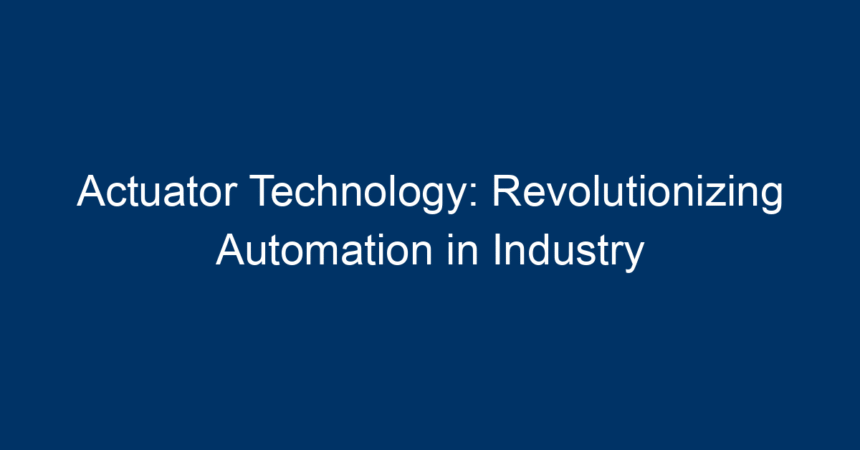In recent years, actuator technology has emerged as a cornerstone of industrial automation, profoundly transforming various sectors. From manufacturing to robotics, actuators are the unsung heroes driving efficiency, precision, and innovation. As industries increasingly turn to automation to remain competitive, understanding actuator technology becomes vital.
This article will explore what actuator technology is, the different types available, their applications, recent advancements, and future trends that signal a revolution in industrial automation.
What is Actuator Technology?
At its core, actuator technology refers to devices that convert energy into motion. These mechanical components take input signals—often electrical, hydraulic, or pneumatic—and output a physical action, such as moving an arm, opening a valve, or positioning a load. Actuators are integral to automated systems, allowing them to perform complex tasks with minimal human intervention.
Types of Actuators
Understanding the different types of actuators is crucial for evaluating their applications in industries. Here’s a breakdown of the most common actuator technologies:
1. Electric Actuators
Electric actuators use electrical energy to produce mechanical motion. They are favored for their precision and controllability, making them ideal for applications requiring exact positioning. Common examples include robotic arms and conveyor systems.
Advantages:
- High efficiency
- Low maintenance
- Simple installation
2. Hydraulic Actuators
These actuators utilize pressurized fluid to generate motion, providing a high force-to-weight ratio. Hydraulic actuators are ideal for heavy lifting and are often used in construction equipment and manufacturing machinery.
Advantages:
- High power output
- Suitable for heavy loads
- Robust and durable
3. Pneumatic Actuators
Utilizing compressed air, pneumatic actuators deliver quick and forceful motion. They are ideal for applications requiring rapid cycles, such as assembly lines in manufacturing.
Advantages:
- Fast operation
- Lightweight
- Cost-effective for high-speed applications
4. Mechanical Actuators
Mechanical actuators convert rotary motion into linear motion through gears, cams, or levers. They are commonly found in various mechanical systems, allowing for simple actuation without complex controls.
Advantages:
- Simplicity
- Durability
- Cost efficiency
Applications of Actuator Technology
Actuator technology plays a critical role in automation across various industries. Here are some key applications:
1. Manufacturing
In the manufacturing sector, actuators are used in robotic systems for assembly, welding, and material handling. They improve production efficiency, reduce waste, and enhance safety standards.
2. Automotive Industry
In modern vehicles, actuators control everything from windows to braking systems. The use of electric actuators in electric vehicles (EVs) is particularly significant, enabling more efficient designs and improved performance.
3. Aerospace and Defense
In the aerospace sector, actuators are critical for controlling aircraft systems, from flaps to landing gear. Their precision and reliability are essential for ensuring safety and performance in flight operations.
4. Healthcare
Actuator technology is making waves in healthcare by automating surgical instruments and prosthetic devices. This leads to enhanced precision during surgeries and improved quality of life for individuals requiring assistive devices.
5. Energy Sector
In renewable energy, actuators manage wind turbine operations, solar panel positioning, and fluid control in hydroelectric systems. Their role in optimizing energy generation is becoming increasingly vital as the world shifts to sustainable energy sources.
Recent Advancements in Actuator Technology
The actuator industry is witnessing rapid advancements driven by technology. Here are some notable trends:
1. Smart Actuators
With the advent of the Internet of Things (IoT), smart actuators equipped with sensors and connectivity features are on the rise. These devices can monitor performance in real-time, allowing for predictive maintenance and enhanced efficiency.
2. Miniaturization
While efficiency and power are crucial, the trend toward miniaturization is allowing actuators to fit into tighter spaces without sacrificing performance. This is particularly beneficial in the medical field, where devices are becoming smaller and more sophisticated.
3. Advanced Materials
The development of new materials, including lightweight composites and high-strength alloys, is enhancing actuator performance and durability. These materials reduce weight without compromising strength, leading to increased efficiency.
4. AI Integration
Artificial intelligence is revolutionizing actuator technology by enabling smarter decision-making in automation systems. AI algorithms can optimize actuator movement, adapt to changing conditions, and improve overall performance.
Future Trends in Actuator Technology
As industries grow increasingly reliant on automation, several trends are set to shape the future of actuator technology:
1. Increased Customization
With advancements in manufacturing techniques such as 3D printing, creating customized actuators to meet specific application needs will become more prevalent. This will drive efficiency and reduce lead times in production.
2. Hybrid Actuators
The development of hybrid actuator systems, combining different technologies (electrical, hydraulic, pneumatic) to enhance performance, is on the rise. These systems can provide the best of both worlds, offering flexibility and power.
3. Sustainability Focus
As industries prioritize sustainability, actuator technology will evolve to become more energy-efficient. The focus will shift toward reducing power consumption and utilizing renewable energy sources to drive actuators.
4. Enhanced Safety Features
With automation comes the responsibility for safety. Future actuators are expected to incorporate advanced safety features, such as emergency stop mechanisms and fallback procedures, to enhance the reliability of automated systems.
Conclusion: Embracing the Future of Actuator Technology
Actuator technology is more than just a mechanical component; it is a critical driver of innovation and efficiency across various industries. As businesses strive for automation, understanding the implications of actuator technology will be essential for staying ahead in a competitive landscape.
Actionable Insights:
- Evaluate Needs: Assess your specific operational requirements to choose the right type of actuator for your applications.
- Stay Informed: Keep an eye on advancements in actuator technology to remain competitive and identify potential areas for improvement.
- Embrace Smart Solutions: Consider integrating smart actuators into your systems to enhance efficiency and reduce maintenance costs.
- Focus on Training: Ensure your workforce is well-versed in the latest actuator technologies to maximize their benefits.
In conclusion, embracing state-of-the-art actuator technologies will help industries not only meet today’s challenges but also pave the way for a smarter, more automated future. As actuator technology continues to evolve, staying up to date will empower organizations to thrive in this new age of industrial automation.




